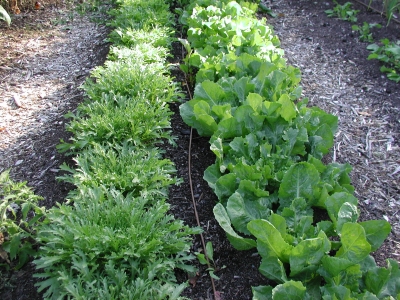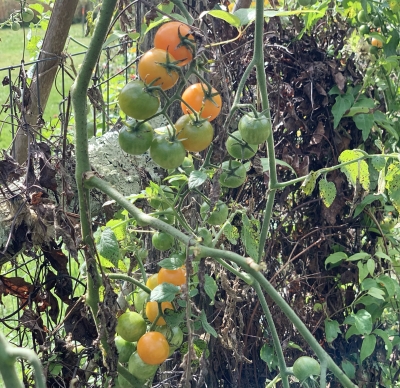AN AUTUMN VEGETABLE FROM FRANCE, FROM BELGIUM, OR IS IT BATAVIA?
/7 Comments/in Gardening, Vegetables/by Lee ReichSaying It is Easy; Naming It, Not so Easy
Pinch your nose with your fingers and say “on.” Follow that with a long, drawn out, “d-e-e-e-e-v,” your mouth in a smile to get emphasis on the e’s. Endive. I once considered endive to be lackluster in flavor, so needed to be offset with this highfalutin pronunciation. After many years of growing endive, I’ve come to recognize a more distinct flavor, nutty and just slightly bitter.

Endive, frisee & escarole
(This is the first time I’ve used “nutty” to describe a flavor, having recently figured out what it means. Nut-like. Duh. Hints of nuttiness are found in the flavors of many foods, including seeds, wines, beans oils, cheeses, fish, and, of course, almonds, hazelnuts, and other actual nuts. Since writing the above description of endive flavor, I learned that others have also described its flavor as nutty. QED)
TOMATOES & CORN, TWO ALL-AMERICANS
/3 Comments/in Planning, Vegetables/by Lee ReichOde to Sungold
As the curtain closes on the summer garden and the autumn garden edges towards its glory, I’d like to offer thanks. No, not a religious thanks for a summer of tomatoes, peppers, cucumbers, okra, and other warm weather vegetables. But thanks to a person, the person who bred Sungold cherry tomato.
Anyone not familiar with Sungold tomato should be. It’s sweet and tangy, not at all cloying, enveloped in persimmon-orange skin. I once grew over 20 varieties of cherry tomatoes (Solanum lycopersicum var. cerasiforme), including Sungold, for a magazine article. As a friend walked down the row, sampling fruit from each plant, she proclaimed, “That’s one row of lousy tomatoes.”
Agreed, excepting a few varieties, one of which was, of course, Sungold. The other exceptions were Gardener’s Delight, Sweet Million, and Suncherry, all three of which are rarely seen these days, probably because Sungold eclipsed the others with its distinctive appearance and, I think, even better flavor.
(My cherry tomato row didn’t include marble-size, so-called currant tomatoes, botanically, S. pimpinellifolium. They are very sweet, very small, and very tasty. I don’t grow them anymore because, for me, they’re too messy, dropping fruits all over the place. The following year, seedlings can grow to become a tomato jungle.)
MORE OF MY FAVORITE TH . . . GRAPE VARIETIES
/3 Comments/in Pests/by Lee ReichThe Birds and the B . . . Vespids
Hot and dry. What great summer weather it’s been here for grapes. Most years around this date, I’d go out every morning and pick bunches for fresh eating, continuing to do so for weeks to come.
Alas, where there are grapes, you’ll find the birds and the be. . . vespids (the family of wasps and hornets, not bees). No raccoons or foxes, here on my grapes, at least. Here you’ll also find paper bags stapled around about a hundred bunches.
The bags are meant to protect the enclosed bunches from birds and insects. This year was a first: Thirsty birds pecked holes in the bags through which they could reach, then peck at the grapes hanging within. By my estimate, about three-quarters of the bagged bunches suffered damage or were finished off in toto.
In addition to the damage inflicted by the birds, the resulting holey bags provide easy entrance to wasps and hornets, who further tear up the bag and finish off the fruit repast started by birds.

